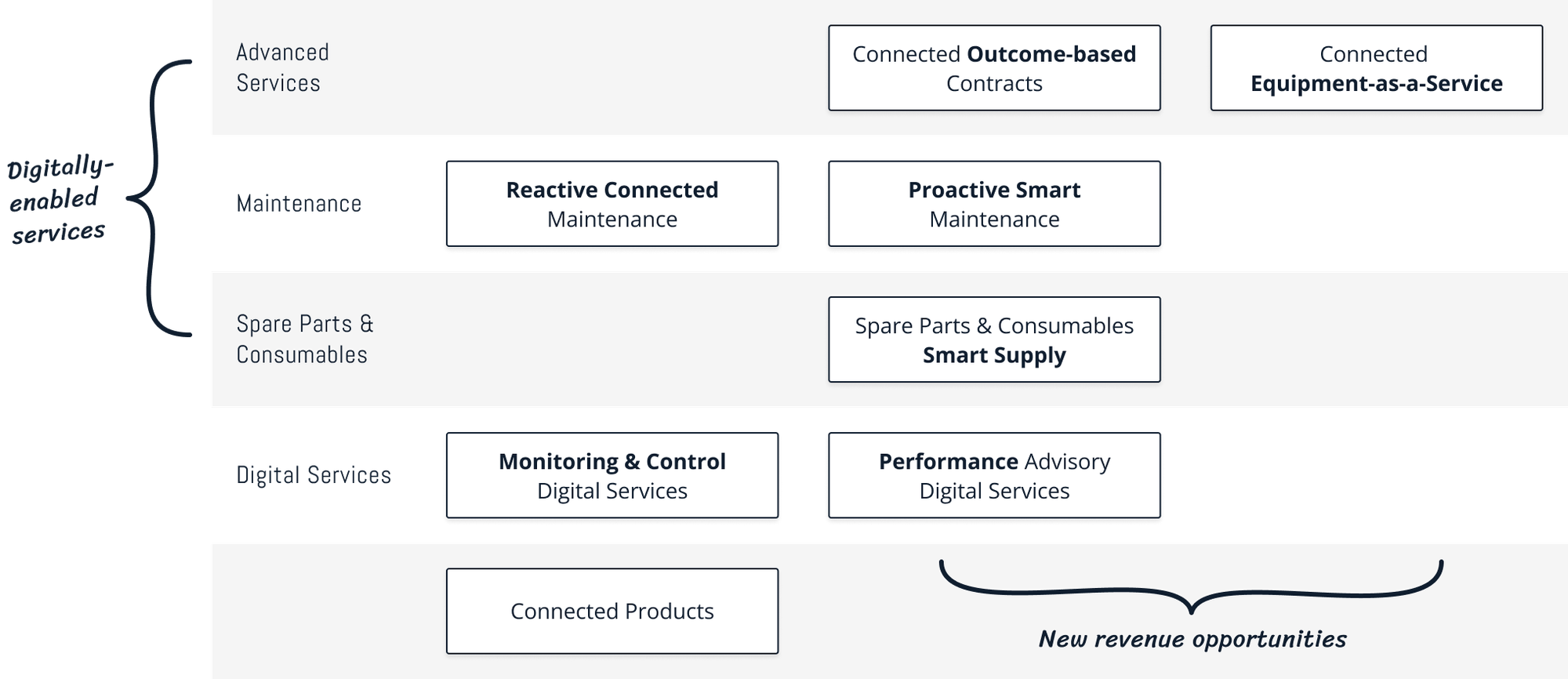A Connected Service is a service you offer to the end customer of your product, made possible by the fact that your product is permanently (or semi-permanently) connected to a central information system (typically a Cloud-based DPS), through IoT technologies.
The basic principle behind a connected service is to leverage data to generate value for your end customer and at the same time keep under control the costs and risks you incur while providing the service.
Several elements can make up the value proposition of a connected service offering. Some are digital elements, and some are “traditional” elements, made more effective and efficient by the digital component.
Digital Services vs Digitally-enabled Services
We distinguish:
- Digital Services: services you deliver only through a digital system and a digital interface → in this case you sell the digital system → the value of services is entirely generated by the digital system
- Digitally-enabled Services: “traditional” services that are enhanced by the use of digital technologies → in this case you use the digital system to make your service more effective and efficient → the value of services is the sum of the value generated by the digital system and your activities
Elements making up a Connected Services offering

Digital Services
Monitoring & Control Digital Services
You offer your end customers a digital solution (typically a Web portal or a Mobile App) providing product monitoring, visualization of real-time status and data through dashboards, alerts notification and remote control capabilities.
Capabilities are enabled and empowered by data collected from your connected products and a two way communication established with them.
Service delivery is fully managed by an information system (typically a Cloud-based DPS) and no staff is actively involved in the delivery.
Performance Advisory Digital Services
Traditionally, the services provided by a manufacturer have focused only on maintenance practices, with the aim of ensuring the health of the product.
A “connected” approach opens up a new horizon.
Data from products allow you to take care of other aspects, more interesting for your customer than “just” health. In a performance advisory service you give recommendations, best practices and suggested configurations that enable your customer to increase productivity, reduce waste, increase quality, reduce consumption and the environmental impact of their operations.
Spare Parts & Consumables
Smart Spare Parts & Consumables Supply
The permanent connection with your products is an excellent basis on which to set up a recurring spare parts and consumables supply service.
Data enable you to measure precisely the health or wear status of components, the available level of consumables, and to estimate precisely when replacement is needed.
Maintenance
Your maintenance activities can be greatly enhanced by data collected from connected products.
We can identify 2 degrees.
Reactive Connected Maintenance
At a first degree, data and information extend and deepen the knowledge of the actual situation in the event of a support request or failure report from a customer.
At this degree, your approach remains reactive: you only act when called upon by a customer.
Proactive Smart Maintenance
Thanks to a permanent connection, a radical change in approach is possible, which favors the delivery of much greater value to the customer.
The transition from a reactive to a proactive approach. This means intelligently performing preventive maintenance activities so as to significantly reduce the probability of failure.
Proactive smart maintenance programs can be:
- usage-based
- condition-based
- predictive
Advanced Services
Connected Outcome-based Contracts
In outcome-based contracts, you take responsibility for guaranteeing the outcomes the customer wants and implements all actions that maximise these outcomes.
The key here is to reach the optimal compromise between acting too infrequently or too late, and thus not guaranteeing the result, and acting too frequently or too early, and thus reducing profit.
A permanent connection, data and all further processing (which typically takes place within a DPS), help with exactly that.
Connected Equipment-as-a-Service (EaaS)
In markets that are ready to accept it, and with the appropriate financial support, a permanent connection is the solid base on which a provider can build an Equipment-as-a-Service (EaaS) offering.
Such an offering will certainly also include Proactive Smart Maintenance, at least.
Furthermore, if the metric for calculating price is not just usage (Pay-per-use) but an outcome (e.g. Pay-per-availability or Pay-per-performance), the service will also include the characteristics of a Connected Outcome-based Contract.
Connected Services and Servitization
Connected services are a frequent result of a servitization journey. Although in fact, theoretically, servitization can also envisage non-connected services, the latter are significantly more expensive, less scalable and less effective in ensuring a positive business impact for both the customer and the provider.
